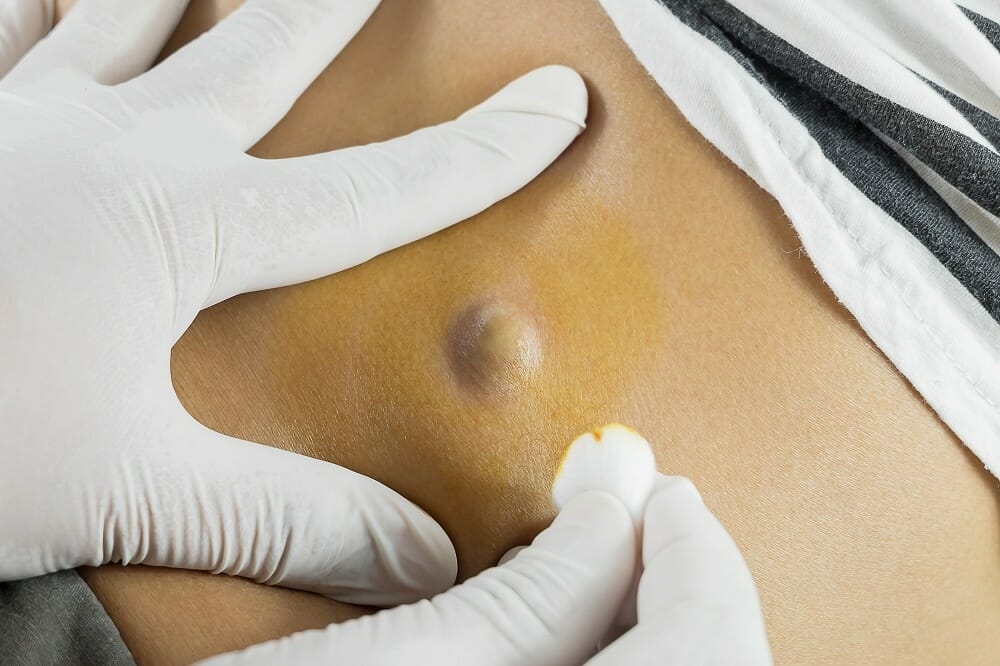
If you have a bump under the skin, it may be a Sebaceous Cyst. The oily liquid that is inside the cyst will make the bump appear yellow or red. Since sebum is produced in areas where the skin is prone to forming fatty cysts, the cyst may smell like a cheese rind. The surrounding area of the skin can also be sore or tender. However, the cyst itself can vary in size and appearance.
Despite their unsightly appearance, a sebaceous cyst is relatively harmless. Most cysts will resolve themselves after a period of time. Some cysts, however, are more problematic and may require treatment. Your physician will usually perform a skin examination and may suggest a biopsy to confirm the diagnosis. For the most accurate diagnosis, the patient should remember to take notes regarding any recent injuries to the affected area, the first time they noticed the cyst, and any family history. The general practitioner will perform a routine exam on you, and may recommend that you visit a dermatologist.
Although sebaceous cysts are often not painful, they can develop into skin abscesses and boils. They can occur at any age and can be uncomfortable to deal with. The condition is not contagious. A sebaceous cyst can go away on its own, but if left untreated, it can persist for years or even a lifetime. A doctor may perform a punch biopsy to check for any signs of cancer.
A skin exam will help your doctor diagnose a sebaceous cyst. A biopsy may be needed to rule out a different condition. A skin exam should also take note of any recent skin injuries, and whether you have a family history of cysts. A physician may order other tests to rule out other potential causes before recommending a treatment. After a diagnosis has been made, the cyst is treated surgically or with topical medicine.
A skin exam will determine the presence of a sebaceous cyst. If the cyst is causing pain, it may need to be removed. A doctor will usually prescribe creams or lotions containing tea tree oil. Although tea tree oil does not have the strength of a synthetic compound, it is an effective antimicrobial agent. The antibacterial properties of tea tree oil can help reduce the appearance of a cyst.
The main cause of a cyst may be a virus or a bacterium. If you have a virus, you can get infected from it. To prevent the cyst from reappearing, avoid sun exposure. Using sunscreen is a good way to prevent acne. It also protects your skin from damage. Sunscreen with SPF is a great way to protect against sebaceous cysts. While a topical cream can help, prevention is the best treatment.
Useful information on cyst prevention can be found at baabin.co.th.
Sebaceous Cysts are harmless but annoying. They can occur anywhere on the face, neck, and even in the body. While they are typically not harmful, they can be a nuisance. They can make a person feel self-conscious and even embarrassed. For this reason, prevention is the best solution. Not only will a reputable professional treat your condition, but he will also help you prevent a sebaceous cyst from returning in the future.
Surgical treatment will be necessary if the cyst becomes infected. Infected sebaceous cysts are usually painful and will need a biopsy to confirm the diagnosis. A biopsy may be needed if the cyst is infected and has spread to the surrounding skin. A surgical removal will be necessary if it has spread to the lymph nodes. A general practitioner will perform a skin exam and may refer a patient to a dermatologist.
Surgical treatment is available for the treatment of sebaceous cysts. A physician will perform a biopsy to confirm that the cyst is not a symptom of another medical problem. Patients should note their recent injuries and any family history of cysts before the procedure. During a consultation, a dermatologist will examine the patient’s skin and determine the best course of action. In many cases, surgical treatment will be the only option if the cyst is infected in a critical area.
